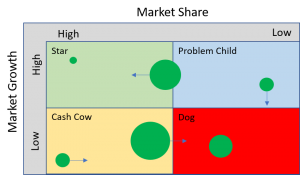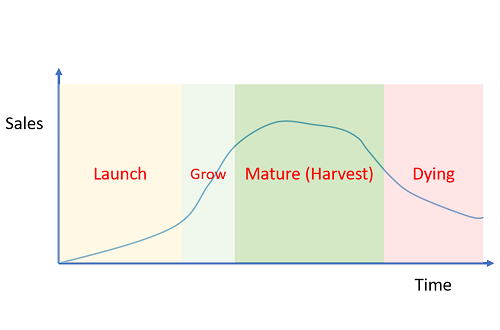Product Life Cycle
One of marketing’s lesser talked about tasks is to manage a products life cycle. Once a product is ready for sale, it passes through four phases before it is finally retired. Each phase requires a different marketing strategy.
Launch
Through this relatively short phase during which revenues are low, the most marketing effort and expense is needed. Having invested in a products development, now is the time to tell people about it. Staff and dealers will need to be trained, websites, brochures and social media updated. A formal launch and public relations activity may be required. Time will be needed to answer queries, meet people and tweak things along the way.
Growth
Following a successful launch, sales should start to grow and revenues improve. Here the marketer needs to keep the momentum going, training more staff, publishing success stories. Competitors are likely to react, so reaction and adjustment to the strategy may be needed. The crucial lesson is to keep your “foot on the gas,” don’t consider it’s job done after the launch.
Maturity and Harvesting
After successfully growing a product, it now enters the key phase, when it pays back the investment and profit is finally made. The task here is to make this phase as long as possible. Minor redesigns, updating specifications, new colour schemes and packaging or even renaming can all help to extend a products sales life. Promotional activity to maintain awareness is needed. Once though it becomes necessary to start heavy discounting, it’s usually a sign it is moving into the Dying phase.
Dying and Phase-out
Once a product is no longer competitive for whatever reason, sales start falling. Several decisions need to be taken; is it still profitable to make and sell, would stopping it too soon damage customer relations and is there a suitable alternative, if not market share may be lost. Often, having recovered development costs, companies will discount or reposition older products to extend their life. As smaller volumes can be more expensive to manufacture, this is not always viable. Make sure figures are studied thoroughly.
The lesson to learn here, is that the replacement for a product should be entering the maturity phase as this one is dying. If the replacement is late, discounting of the older product becomes necessary and overall revenues fall. This brings us onto our next topic, The Boston Matrix, a tool enabling us to compare the phases of several products at once.
The Boston Matrix
 In the Boston Matrix, there are four zones.
In the Boston Matrix, there are four zones.
Stars – For products with high market shares in a high growth market
Cash Cows – Products with high market share but in a mature or declining market
Problem Childs – Products with low market share in market with high growth
Dogs – Products with poor market share in a mature or declining market.
The size of the circles represent the relative value of turnover compared to others. The arrows show the expected trend over time. Several versions can be made for what is expected in 1,2 or more years.
The Matrix is useful tool because it allows you, in one view to see where revenue is coming from now and in the future. It also indicates your market share and importantly illustrates gaps in your portfolio. This is a simplified explanation, plenty more can be found online.
Typically a new product starts as a Problem Child. If successful it should as sales and market share increase become a Star. Some new products fail to take off. They may be late to the market, not competitive or poorly promoted, these will end up as Dogs, and unless remedial action is possible, should be killed off before more money is wasted.
Over time, as a market matures, Stars will mostly migrate to Cash Cows where profits should be made. If they lose market share they will move instead to being a Problem Child again, requiring action to resolve.
As we saw earlier at some stage a product edges towards it’s end of life, this can be because the market is declining and/or the product becomes too old or non competitive. As this occurs, they move from being Cash Cows to Dogs.
Danger Signs
The Boston Matrix is a useful way of seeing at a glance what is right, and more importantly wrong with your product portfolio.
- Ideally you want products for the future growing as Problem Childs, some Stars and some Cash Cows to pay the bills. Ideally there should be no Dogs.
- If most products are Problem Childs. Whilst the future may look bright, you could be facing cash flow issues if there are insufficient Cash Cows to pay the bills.
- A similar, but less serious scenario can apply if you have all Stars and no Cash Cows, if the turnover is low. Cash may be tight, but you are much nearer to turning a profit as these grow.
- Having Cash Cows but few or no Stars and Problem Childs is a classic problem, and the reason many businesses fail. This is the classic case where business is good today, but there are no products for the future. Development budgets are often trimmed when money is tight. The result isn’t felt immediately but down the line when Cash Cows become Dogs and there is nothing to replace them.
- Once a product is a Dog, it’s likely to be heavily discounted, volumes falling and it’s production may be causing manufacturing inefficiencies. Too many Dogs demonstrates something needs urgent action.
Managing your Portfolio
Few products sell forever, although lifespans differ widely between industries. Although we have talked about physical products and mentioned manufacturing, the same tools are useful for service providers as well. In law and accountancy for example new opportunities frequently arise. In construction, new tools, materials and processes evolve.
A former mentor or mine said as soon as you stop moving forward in business, you start going backwards, good advice. Unless you are in monopoly position, competitive actions will require you to continuously evolve.
The tools we have looked at provide a snapshot of your portfolio, allowing you to see potential wins and losses and ahead and plan accordingly. If products are growing, do you have the skills and plant needed to support the growth. If decline is forecast are there plans to introduce or source alternative products to replace them.
 B2B-Club Connecting SME's Nationwide
B2B-Club Connecting SME's Nationwide


